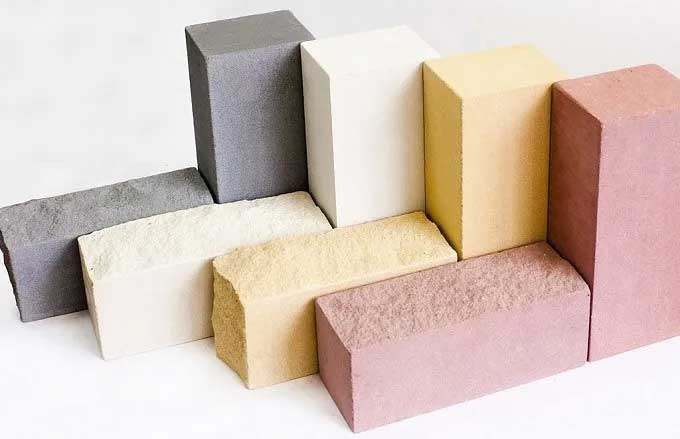
Sand Lime Bricks and Blocks
Description:
Building Material Category: Bricks and Blocks
Building Component Type: Wall
Alternative for Conventional Building Material: Traditional clay bricks and concrete blocks
Introduction: Sand lime bricks and blocks are made from a mixture of sand, lime, and water, which are combined and then compressed under high pressure and cured in a steam chamber. This process results in a dense, durable product that is used for building construction. The material is known for its strength, fire resistance, and eco-friendly properties.
The resulting sand lime bricks and blocks are recognized for their exceptional strength and structural integrity. The high-pressure compression and steam curing create a dense, solid product that is highly resistant to weathering, impact, and fire. Their fire resistance is particularly notable, making them an excellent choice for enhancing the safety and resilience of buildings.
In addition to their strength and durability, sand lime bricks and blocks are also celebrated for their environmental benefits. The use of lime, which is produced from natural limestone, and the recycling of industrial byproducts, contributes to their eco-friendly profile. The manufacturing process for sand lime bricks is less energy-intensive compared to traditional clay brick production, resulting in a lower overall carbon footprint.Top of FormBottom of Form
Composition: The primary materials used are sand, lime, and water. Additives used may include pigments for coloring or other agents to enhance properties. The mixture is then compressed into molds and cured using steam to achieve the final product.
Applicability in Climatic Zone: For warm and humid climatic zone it offers good thermal mass, which helps in stabilizing indoor temperatures by reducing heat gain. For temperate climate it provides effective insulation and durability, suited for varying weather conditions. For hot and dry climate, it performs well by maintaining a stable indoor temperature and resisting thermal fluctuations.
Use: It can be used in walls, partitions, and load-bearing structures. It is ideal for residential, commercial, and institutional buildings.
Thermal Performance: It provides moderate insulation, helping to stabilize indoor temperatures and improve energy efficiency. The high density of sand lime bricks helps in absorbing and slowly releasing heat, contributing to thermal comfort.
Thermal Conductivity: It typically ranges from 0.7 to 1.0 W/m·K, which is higher than traditional clay bricks but provides better thermal mass.
Thermal Transmittance: It provides moderate thermal transmittance due to the material's density, affecting how well it retains or transfers heat.
Reduction in CO2 Emission: The use of lime instead of cement in the production process reduces CO2 emissions compared to traditional cement-based materials. The production process and raw materials contribute to a lower overall carbon footprint compared to conventional bricks and blocks.
Salient Features:
-
High Strength: Sand lime bricks and blocks exhibit excellent compressive strength, making them suitable for load-bearing walls and structures.
-
Durability: They offer exceptional durability and resistance to weathering, ensuring long-lasting performance in various environmental conditions.
-
Fire Resistance: The dense composition provides excellent fire resistance, enhancing the safety of buildings by reducing the spread of flames and heat.
-
Low Water Absorption: These bricks have low water absorption rates, minimizing the risk of moisture-related issues such as efflorescence and deterioration.
-
Eco-Friendly: The production process is more environmentally friendly compared to traditional clay bricks, utilizing lime and reducing overall carbon emissions.
-
Thermal Insulation: It offers moderate thermal insulation, contributing to energy efficiency by maintaining stable indoor temperatures.
-
Dimensional Accuracy: It is manufactured with precise dimensions, ensuring uniformity and ease of construction with reduced need for adjustments.
-
Reduced Environmental Impact: It utilizes industrial byproducts and requires less energy for production, promoting sustainability and reducing waste.
-
Good Aesthetic Quality: Available in various finishes and colors, allowing for aesthetic versatility in building design.
-
Low Maintenance: Requires minimal maintenance due to its resistance to weathering and low porosity, leading to fewer repairs and lower lifecycle costs.
Indian Codes:
-
IS 2185 (Part 1): 2005 - Concrete masonry units – Specification:Includes guidelines for the production and testing of concrete blocks, which are relevant for understanding sand lime bricks and blocks.
-
IS 10409: 1982 - Sand Lime Bricks:Provides specific standards for the manufacturing and testing of sand lime bricks.
-
IS 1077: 1992 - Common Burnt Clay Building Bricks:Although focused on clay bricks, it provides context for comparisons with sand lime bricks.
International Codes:
-
BS EN 771-2: Specification for Masonry Units – Part 2: Aggregate concrete masonry units:Covers standards for concrete and sand lime masonry units.
-
ASTM C90: Standard Specification for Loadbearing Concrete Masonry Units:Provides specifications relevant to the performance and testing of concrete masonry units, including those made from lime and sand.
-
ISO 6784: Masonry units - Determination of water absorption and moisture content:Relevant for assessing the water resistance of masonry units.
Sources: